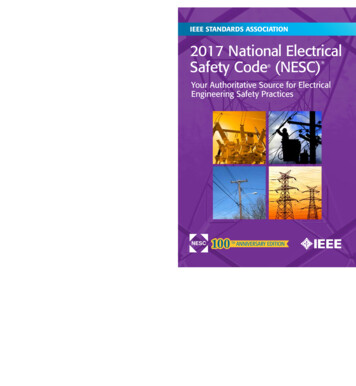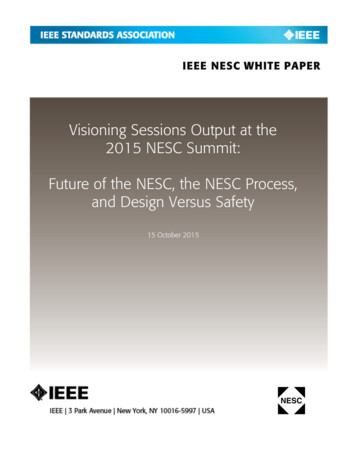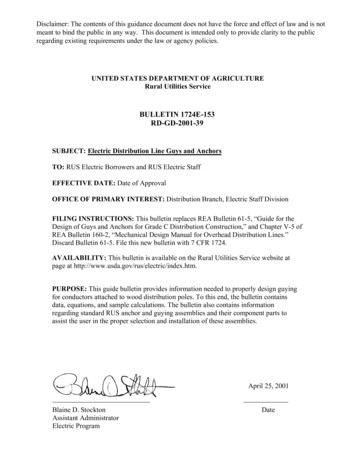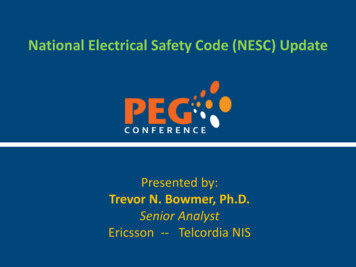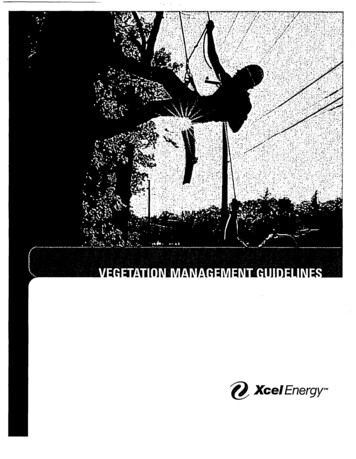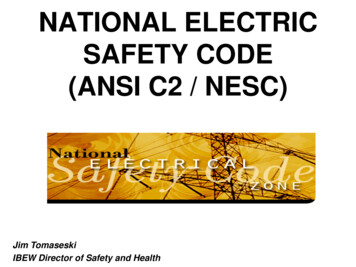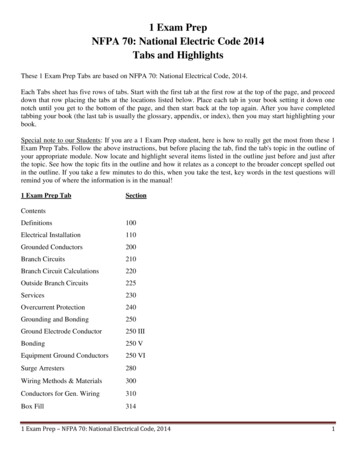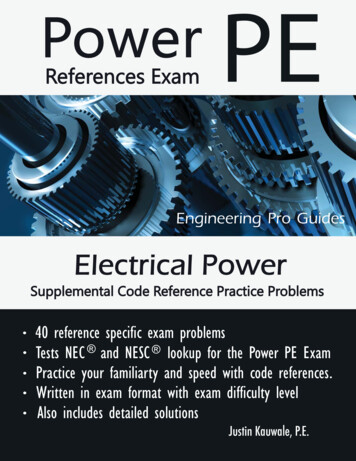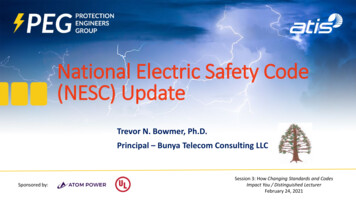
Transcription
National Electric Safety Code(NESC) UpdateTrevor N. Bowmer, Ph.D.Principal – Bunya Telecom Consulting LLCSponsored by:Session 3: How Changing Standards and CodesImpact You / Distinguished LecturerFebruary 24, 2021
IEEE – NESCCodes in Context Industry Safety Codes and Standards Regulatory Rules . . Legal Mandates Internal Practices Engineering DesignSponsored by: NFPA -- NEC GO-95 .GO128 .GO165 OSHA 1910.268/269 Internal M&Ps GRs and UL Listings Joint Use Agreements (JUA) UL GRs/SRs ATIS etc Session 3: How Changing Standards and CodesImpact You / Distinguished LecturerFebruary 24, 2021
2017 2022 2023 NESC Purpose & ScopePurpose - The practical safeguarding of persons, utility facilities, and affectedproperty during the installation, operation, and maintenance of electric supplyand communications facilities.Scope - covers supply and communication facilities and associated workpractices employed by a electric supply, communications, or railway in theexercise of its functions as a utility.“NESC is Not a Design Guide or Instruction Manual “Sponsored by:Session 3: How Changing Standards and CodesImpact You / Distinguished LecturerFebruary 24, 2021
NESC GOVERNANCE STRUCTURE SC1 - Scope and PurposeSC2 - Grounding MethodsSC3 - Part 1 - Substations and Generation FacilitiesSC4 - Part 2 - Overhead Lines - ClearancesSC5 - Part 2 - Overhead Lines - Strength & LoadingSC7 - Part 3- Underground LinesSC8 - Part 4 - Work RulesSponsored by:Main Committee – Provides oversight responsibilityExecutive Committee – General oversight of NESCdirection and policySession 3: How Changing Standards and CodesImpact You / Distinguished LecturerFebruary 24, 2021
2017 -2022 2023 Revision - Multi-Step Process 5-year Revision Schedule Administered by IEEE ANSI Approved– TIA and Fast-Trac processes exist for more rapid responses as technology accelerates 2022 NESC Preprint issued (Sept. 2019) 465 Public Comments (PCs) on Preprint received March 2nd 2020*** Pandemic Pause 1 year Deferment *** SC action in Aug-Oct 2020 was delayed 1 year until Aug-Oct 2021 (tentative) Release of 2023 Code now scheduled for Aug 2022 with Effective Date of Feb 2023 Applies on adoption by PUC, State legislative or local AHJ bodiesSponsored by:Session 3: How Changing Standards and CodesImpact You / Distinguished LecturerFebruary 24, 2021
CHANGES ACCEPTED Expected to be in 2023 Code Traditional View Reinforced - Focus on People Safety rather than facilities Explicit inclusion of grid-connected generation facilities (solar farms, battery arrays) Definitions - Clarifications of Communications Lines – Operate at potentials exceeding 400 V to ground or 750 V between any two points of the circuitTransmitted power of which does not exceed 150 WMore than 150 W is permitted if operating voltages are not more than 90 V ac or 150 V dc Clearances – Refinements to 215, 232, 235H, . Wireless Consolidations/Clarifications - 235I, 238, 239 new 238F 410A6 & 420Q Work Rules - Harmony with OSHA, Battery Work Rules, RF Exposure (410A6, 420Q)Sponsored by:Session 3: How Changing Standards and CodesImpact You / Distinguished LecturerFebruary 24, 2021
“ACCEPTED” CHANGES - ACTIVE DEBATEMajor disputes remain – These issues are expected (or hoped) to bemodified or resolved at the 2021 Public Comment SC meetings Grounding – Rule 094B on ground rods– minimum trade, nominal or exact size need clarification Wind Map - Modernization in Strength & Loading Section (Section25 in flux) with new wind/ice maps needing resolutionSponsored by:Session 3: How Changing Standards and CodesImpact You / Distinguished LecturerFebruary 24, 2021
GROUNDING METHODS - Section 09Ground Rods - Rule 094B - The requirements for ground rods were relaxed by removing material specific detailand permitting any rod to be 0.5-inch minimum diameter. The current 2017 Rule 094B2a(1) reflects the historical experience and field test data on ground rodperformance as well as product specifications used by most utilities. Strongly recommend that communications companies maintain their current practices and productspecifications to require a 5/8-inch inch diameter copper-clad stainless-steel ground rod as the primarychoice rod material and size - as it has been for over 70 years.Grounding Intervals - Effective Grounding of MGN - Rule 096C - Rule 096C was modified for simplicity and clarityparticularly within the exceptions. 4 grounds for each mile remains the basic effectively grounded criteria.Intersystem Bonding at Poles - Rule 097G - The previously revised Rule 097G was re-affirmedCustomer Premises Intersystem Bonding – Rule 099 – correlates mostly with NECSponsored by:Session 3: How Changing Standards and CodesImpact You / Distinguished LecturerFebruary 24, 2021
MODERNIZATION OF POLE LOADING CALCULATIONS NESC Sections 24-26 (Loading) and new wind and ice maps in ASCE-7 and ASCE-74 Current approach is to retain continuity of traditional approaches to pole strength and loadingwhile updating to the latest wind/ice maps to maintain or enhance pole safety without resultingin over-designing of pole plant. Therefore, our preferred strategy is to Retain the 60-feet limit Clarify Grade N criteria Update to 100-MRI (mean-return-interval) maps with 0.87 for Grade B and 1.0 for Grade C Clarify appropriate construction grades Continue the use of additive k-factor to maintain consistency as an interim measure, andto not disadvantage current industry best practices.Sponsored by:Session 3: How Changing Standards and CodesImpact You / Distinguished LecturerFebruary 24, 2021
CONGESTIONANDCOMPETITIONFOR SPACESponsored by:Session 3: How Changing Standards and CodesImpact You / Distinguished LecturerFebruary 24, 2021
NESC RELEVANT RULES – Wireless and Broadband DeploymentsDefinition of Communications Lines (Section 02) – provides flexibility to designersIntersystem Bonding and Grounding (Section 09) – Rules 097 and 099Powering Circuits in Communications Cables – Rules 224 and 344Strand Mounted Facilities – 235H and Section 25 (loading)New Rule 238F – Communication antenna clearances – consolidation has benefitsWork Rules – Revised Rule 410A6 and 420Q - RF Exposure – RF safety training withreference to IEEE 1654 and C95 useful additions for safety guidance.Other design/engineering choices about wireless deployments in general and about5G installations in particular, are better addressed and more appropriately covered byindustry forums, product specifications, IEEE initiatives, and inter-utility agreements.Sponsored by:Session 3: How Changing Standards and CodesImpact You / Distinguished LecturerFebruary 24, 2021
RULE 097 – Grounding & Intersystem BondingRule 097 has 7 interlocking sections with implicit/explicit links to other Rules (e.g., 096, 224, 344, 354,384) applicable to intersystem bonds Rule 097A -- separate grounding conductors Rule 097B – permits a bond to the power ground if MGN system is used and 4 grounds/mile Rule 097C - 4 grounds/mile criteria help to define an effective ground as per NESC Rule 097G requires a single grounding conductor on structures except as required by Rule 097A– Where both electric supply systems and communication systems are grounded on a joint usestructure and a single grounding conductor is present, the grounding conductor shall beconnected to both systems.097G sets expectation that a bond to vertical ground should be made unless anexplicit technical or safety reason not to bond exists.Sponsored by:Session 3: How Changing Standards and CodesImpact You / Distinguished LecturerFebruary 24, 2021
POWER CIRCUITS FOR COMMUNICATIONS EQUIPMENTCircuits used exclusively for supplying power to communications equipment Are treated as “communications lines” under the NESC if Less than 400 V to ground or 750 V between any two points of the circuit Transmitted power does not exceed 150 W Operating at more than 90 Vac or 150 Vdc and more than 150W then 224B/344A apply Cables will have a shield and be effectively grounded Maintained by qualified (trained) persons Access to Termination points are restricted Under fault conditions voltage on communications circuit shall be less than 400 V to ground Live parts will be inaccessible when circuit is energized.Sponsored by:Session 3: How Changing Standards and CodesImpact You / Distinguished LecturerFebruary 24, 2021
IEEE 5G JOINT ALLIANCEOctober 2019 – IEEE White Paper – “Establishing Consistency in Joint Use Applications with 5G Wireless onnections/facilities-joint-use-program.htmlMay 2020 to Jan 2021 IEEE Guide 2939 being developed under sponsorship of Joint Use Committee of the IEEEPower and Energy Society [https://standards.ieee.org/project/2939.html] with objectives to Help establish the requirements of a “complete application” Identify ways/means to share information regarding facility availability. Guidelines on Clearances and Loading Analysis – based on NESC Installation and Maintenance Procedures and Work Rules RF Emissions and Interference guidelinesWorking Title - IEEE Guide for the Joint Use of Overhead Lines, Including Wireless FacilitiesCoordinate and develop consistent approaches, methodologies and rules for the sharing and co-location of equipmentwith electric facilities including wireless facilities.Sponsored by:Session 3: How Changing Standards and CodesImpact You / Distinguished LecturerFebruary 24, 2021
NESC - ongoing interactionsInterpretation Requests (IRs)Tentative Interim Amendments (TIAs)Design – EngineeringFast Trac ProceduresOperational M&PsAug-Oct 2021Functional PerformancePublic CommentSpecificationsSubcommittee MeetingsGRs, ATIS, 2022NESC 2023 settledSponsored by:Industry GuidesBest PracticesRegulationsSession 3: How Changing Standards and CodesImpact You / Distinguished LecturerFebruary 24, 2021
RELATED EFFORTS – Harmonized with NESCExamples of Functional Performance Documents GR-1089 – EMC GR-3108 – OSP Equipment GR-3171 GR-3178 Wireless Facilities GR-513 – Powering FCC - OET Bulletin 65Sponsored by:Session 3: How Changing Standards and CodesImpact You / Distinguished LecturerFebruary 24, 2021
RELATED EFFORTS – ATIS Examples0600030 - Line-Powering of Telecom Equipment on Outside Plant Copper Twisted Pair Loops0600012 - Electrical Protection Considerations for Broadband Systems0600013 - Electromagnetic Compatibility (EMC) and Electrical Protection0600315 - Voltage Levels for DC-Powered Equipment Used in the Telecom Environment0600316 - Electrical Protection of Telecommunications Outside Plant.0600318 - Electrical Protection Applied to Telecom Network Plant at Customer Entrances0600332 - Electrical Protection of Network-Powered Broadband Facilities0600334 - Electrical Protection of Communications Towers and Associated Structures0600337 - Maximum Voltage, Current, and Power Levels Used in Communications Circuits0600338 - Electrical Coordination of Primary and Secondary Surge ProtectionSponsored by:Session 3: How Changing Standards and CodesImpact You / Distinguished LecturerFebruary 24, 2021
RELATED EFFORTS2021-2022Issue 7 PlannedSponsored by:Session 3: How Changing Standards and CodesImpact You / Distinguished LecturerFebruary 24, 2021
2022 NESC Preprint issued (Sept. 2019) 465 Public Comments (PCs) on Preprint received March 2. nd. 2020 *** Pandemic Pause 1 year Deferment *** SC action in Aug-Oct 2020 was delayed 1 year until Aug-Oct 2021 (tentative) Release of 2023 Code now scheduled for Aug 2022 with Effective Date of Feb 2023
